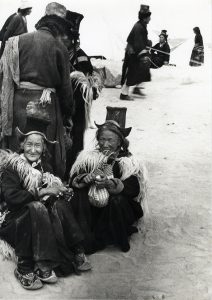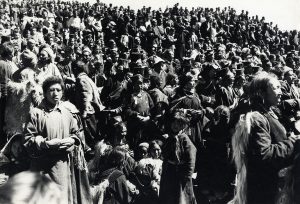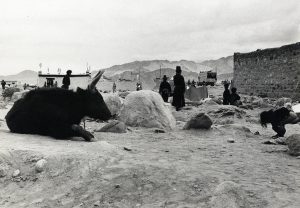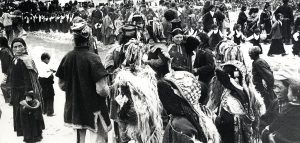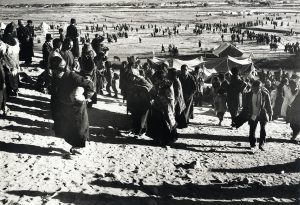This book tells the story of an extraordinary collaboration that culminated in 1976 in the form of a precious documentation of all the ethnic groups in Ladakh (India), who had gathered on a remote 4000m high plateau on the border to meet the Dalai Lama. At Giacomelli’s request, Enea Disceopoli photographed one of his journeys to the East, and Giacomelli printed the project. The land of long shadows was the result.
‘The 1970s…libertarianism, social rights, women’s emancipation, the Red Brigade, strikes, lockouts. Those of us with an adventurous spirit were looking Eastwards, eager to escape the fray. The East is where the sun rises, so said Kipling; they see the light first.
When I came back to Senigallia, Mario was always keen to hear about my adventures. Senigallia…the typography – and its owner – was like Alì Babà’s cave, full of joy and the smell of inks. I was the adventurer who pitched up from time to time, bringing with me strange figurines, glinting stones, and marvellous stories. It was a real honour to have unrestricted access to the typography, and to see Giacomelli’s beautiful poetry in image-form in the making. Ahead of my journey to Ladakh, Mario pored over detailed atlases, and read up on the mountain ranges, Tibet, and Buddhism. In 1976, he bought me the equipment for the project. It was a 1975 model Single-Lens Rolleiflex 24×36, one of the first cameras with an integrated exposure meter, made entirely from robust metal, and with a bright image quality. He bought it so that I could photograph the places I visited on my next journey.
[…] I photographed Ladakh in an almost trance-like state. I took the photographs especially for Giacomelli and I wanted him to be happy with the work, even if this went against my adventurous spirit, which meant living in the moment, rather than through the lens of a camera…But he made me realise that adventure (mine in particular) could be accompanied by photography, and that this could bring the adventure itself to life. Roland Barthes (it was Giacomelli who introduced me to his work) writes: ‘The photograph itself is in no way animated (I do not believe in “lifelike” photographs), but it animates me: this is what creates every adventure.’
After I returned from Ladakh, and I had taken the rolls of film to Giacomelli, one day he called me round to see the printed photographs, 30x40cm in size, on heavyweight baryta paper. The results left me feeling cold, and perhaps my disillusionment showed [Giacomelli had dramatically cropped the images and printed them with a grainy effect, which meant they were quite unlike the reportage style that Enea was expecting].’
(E Discepoli, extract from the book Mario Giacomelli. The land of the long shadows, Arte Com, Senigallia, 2011)
This was Giacomelli’s approach to photography: he manipulated the material, cropped the framing, and used strong contrasts to isolate and abstract his subject, decontextualising it in order to allow its significance to resound around the space, and to give the images different moods. He focused on expressions and small details enfolded into the image, rather than the image as a whole. This allows Giacomelli to communicate meaning more directly; he distanced himself from reality to seek out the poetry of human nature. Giacomelli’s printed photographs were very different from Enea’s originals
- Flexible cover: 141 pages
Printer: ArteCom, Municipality of Senigallia (first edition July 2011)
Language: Italian / English
Texts by Katiuscia Biondi



